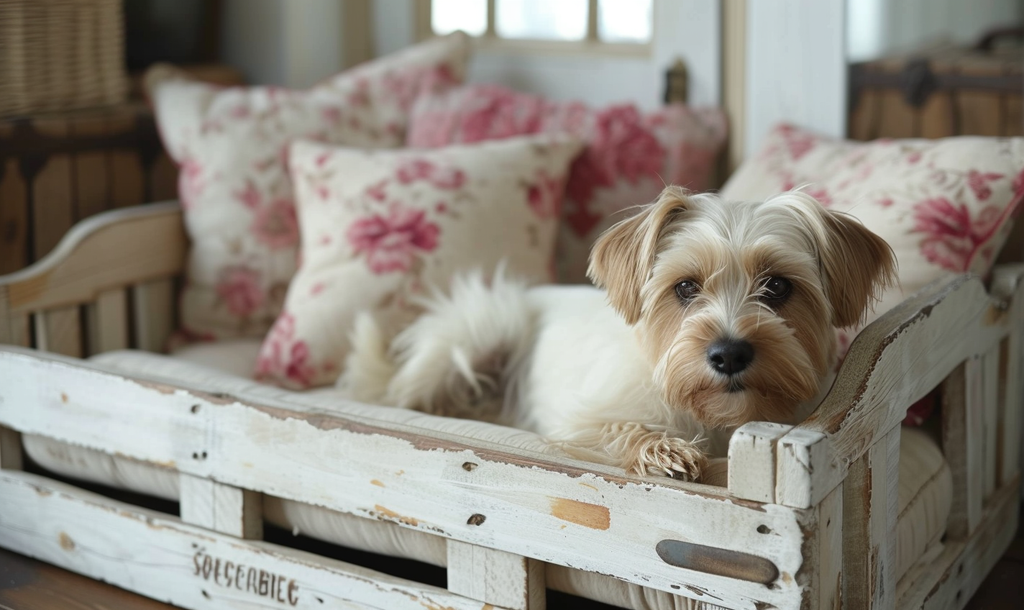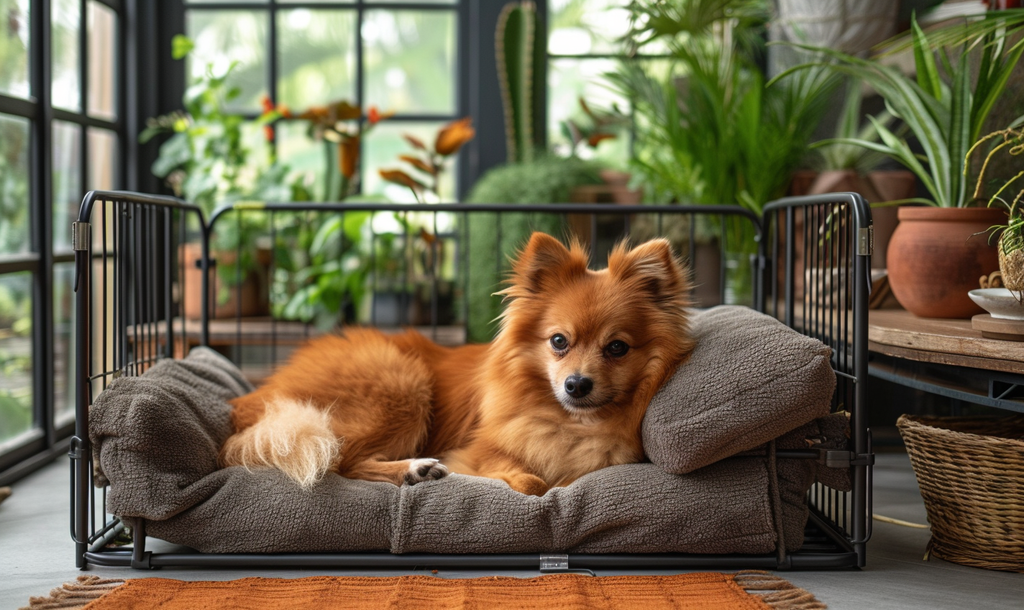Introduction:
When it comes to providing a comfortable and secure space for your furry friend, choosing the right size for a dog crate is crucial. A dog crate serves various purposes, from training to providing a safe haven for your pet. In this comprehensive guide, we will explore the factors to consider when determining the size of a dog crate and address some frequently asked questions on this topic.

l Factors to Consider:
Choosing the right size for your dog's crate is a crucial decision that directly impacts their well-being and comfort. Let's delve deeper into the factors mentioned earlier, providing a more detailed understanding of each aspect.
1. Breed Size:
Understanding the breed size of your dog is a critical factor in choosing the right crate for their needs. Dogs, ranging from tiny toy breeds to large working dogs, have distinct size characteristics that directly influence the appropriate crate size. For larger breeds like Great Danes or German Shepherds, it's crucial to opt for more spacious crates to accommodate their full-grown size. These breeds require ample room to move around, stretch, and feel comfortable within the crate.
Conversely, smaller breeds such as Chihuahuas or Pomeranians will find smaller crates more suitable. Providing a crate that aligns with their size ensures a cozy and secure environment. It's important to recognize that choosing a crate that matches your dog's breed size contributes to their overall well-being. By offering the right amount of space, you create a space that meets their specific needs, promoting a positive association with the crate and fostering a sense of security for your furry companion.

2. Weight and Height:
Accurate measurement of your dog's weight and height is a crucial aspect when choosing the right crate size. It goes beyond a mere formality, as the dimensions directly impact your dog's comfort and well-being. The crate should provide sufficient space for your dog to perform essential movements – standing, sitting, lying down, and turning around – with ease.
A crate that is too restrictive can have detrimental effects on your dog's physical and mental health. Discomfort and stress may arise, leading to an unpleasant association with the crate. Moreover, it can result in physical health issues if your dog is forced into uncomfortable positions for extended periods.
To ensure an optimal fit, take precise measurements of your dog's height and length. Consider the overall body structure, as some dogs may be leaner or stockier even within the same weight range. By investing time in accurate measurements and understanding your dog's specific needs, you contribute to creating a positive and comfortable space within the crate. This, in turn, fosters a positive relationship between your dog and their designated living space.
3. Age and Growth:
Considering the age and growth of your puppy is a key factor in selecting an appropriate crate size. Puppies experience rapid growth during their early months, and choosing a crate that anticipates their future size is essential for their comfort and well-being.
Many crates on the market come equipped with dividers, providing a practical solution for adjusting the available space as your puppy grows. This feature is not only convenient but also cost-effective, sparing you the need to continually purchase new crates to accommodate your growing pup. By utilizing dividers, you can ensure that the crate remains a suitable and secure environment for your puppy at every stage of their development.
The adjustable nature of these crates allows you to create a cozy and appropriately sized space for your puppy, promoting a positive association with the crate. As your puppy grows, you can modify the crate accordingly, maintaining a comfortable and secure haven for them. This thoughtful approach not only facilitates effective crate training but also establishes a positive and lasting relationship between your puppy and their designated space.

4. Purpose of the Crate:
Understanding the primary purpose of the crate is paramount when selecting the appropriate size for your dog. Crates serve various functions, such as training, travel, and providing a safe space at home. Tailoring the crate size to its intended purpose ensures the best possible environment for your furry friend.
For training purposes, the crate should be just large enough to accommodate your dog comfortably while discouraging bathroom accidents. A snug fit prevents your dog from designating one area of the crate for sleeping and another for eliminating waste, promoting effective house training.
When it comes to travel crates, specific size requirements may exist based on airline regulations. It's essential to check and comply with these guidelines to ensure a smooth and stress-free journey for both you and your pet.
On the home front, a crate used as a safe space should be cozy and inviting, serving as a retreat for your dog. This crate becomes a personal haven where your dog can seek comfort and security, fostering a positive association with the space. By aligning the crate size with its intended purpose, you contribute to the overall success of crate training and create a positive and functional space for your canine companion.
5. Comfort and Safety:
Ensuring both comfort and safety within a crate is essential to create a positive experience for your dog. A crate should transcend its role as a mere containment area and transform into a comfortable and secure haven for your furry companion.
One critical aspect of ensuring comfort is adequate ventilation, particularly crucial in warmer climates. Opt for a crate with well-designed openings that allow for proper airflow, preventing overheating and ensuring your dog remains cool and comfortable. Proper ventilation also contributes to a pleasant environment that encourages relaxation.
Safety considerations are equally vital. Before selecting a crate, thoroughly examine its construction. Ensure that all components, including latches, locks, and the overall structure, are robust and secure. This precautionary measure is crucial in preventing any potential accidents or escapes, guaranteeing your dog's safety while inside the crate.
Double-checking the functionality of latches and locks is particularly important, as any vulnerability in these areas could compromise the security of the crate. A secure and stable environment not only prevents accidents but also fosters a sense of safety and well-being for your furry friend within their designated space. By prioritizing comfort and safety, you create a positive association with the crate, making it a welcoming and secure retreat for your dog.
In conclusion, selecting the right size for a dog crate involves a thoughtful consideration of your dog's breed, size, age, and the intended purpose of the crate. By prioritizing your dog's comfort and safety, you can create a positive and enjoyable space that contributes to their overall well-being. Remember to measure accurately, anticipate growth, and choose a crate that aligns with your dog's specific needs.

l Determining the Right Size
Determining the right size for a dog crate is a crucial step in ensuring your furry friend's comfort and well-being. By following a systematic approach, you can tailor the crate dimensions to your dog's specific needs, taking into account factors such as size, growth, manufacturer guidelines, behavior, and careful observation.
1. Measure Your Dog:
Measuring your dog accurately is the foundational step in selecting the right crate size, and it plays a pivotal role in ensuring your furry friend's comfort and well-being. This process involves taking precise measurements of three key aspects: height, length, and weight.
Begin by measuring your dog's height, starting from the floor to the highest point of their shoulders. Next, measure their length from the tip of their nose to the base of their tail. Finally, determine their weight by using a reliable scale.
These measurements provide essential information that guides you in choosing a crate that accommodates your dog's size appropriately. A well-fitted crate allows for comfortable movement, ensuring that your dog can stand, sit, lie down, and turn around without restriction.
Considering your dog's unique dimensions is particularly crucial if you have a puppy. Puppies grow rapidly, and anticipating their potential adult size helps in selecting a crate that will accommodate their growth. Many crates come with dividers, allowing you to adapt the available space as your puppy matures, providing a cost-effective and practical solution.
By taking the time to measure your dog accurately, you lay the groundwork for creating a positive and comfortable living space within the crate. This individualized approach ensures that the crate becomes a welcoming and secure haven for your dog, promoting a harmonious relationship between your pet and their designated resting area.

2. Consider Growth:
Contemplating the growth of a puppy is a pivotal aspect when determining the right size for a dog crate. Puppies undergo rapid development during their early months, and choosing a crate that takes into account their potential adult size is essential for long-term comfort and practicality.
Many crates available in the market come equipped with dividers, offering a versatile solution to adjust the crate's space as your puppy grows. This feature not only proves to be cost-effective but also addresses the changing needs of your growing canine companion. By utilizing dividers, you can provide a cozy and appropriately sized space for your puppy, fostering a positive association with the crate from an early age.
Considering the growth factor ensures that the crate remains a suitable and secure environment at every stage of your puppy's development. This forward-thinking approach not only saves you from the hassle of constantly purchasing new crates but also contributes to effective crate training by maintaining a consistent and comfortable living space for your growing puppy.
3. Check Manufacturer Guidelines:
Checking manufacturer guidelines is a crucial step in determining the appropriate size for a dog crate. Many crate manufacturers provide size recommendations based on different dog breeds, offering valuable insights into the suitable dimensions for various breeds. These guidelines serve as a helpful starting point for pet owners who may be uncertain about the ideal crate size for their specific breed.
It's important to recognize that these recommendations are general guidelines and may not account for the individual variations within a breed. Dogs of the same breed can have different sizes, weights, and preferences. Therefore, while manufacturer guidelines provide useful reference points, they should be used as a starting guide rather than a strict rule.
To optimize the crate size for your dog, consider factors such as your dog's unique measurements, behaviors, and comfort preferences. Combining manufacturer recommendations with personalized observations ensures a more accurate and tailored approach to selecting the crate that best suits your individual pet. This thoughtful consideration enhances the effectiveness of crate usage and contributes to your dog's overall well-being and happiness.
4. Observe Behavior:
Observing your dog's behavior is a key element in selecting the ideal crate size that caters to their individual comfort and well-being. Paying attention to how your dog prefers to rest provides valuable insights into their personal space preferences.
Dogs exhibit various sleeping positions – some stretch out, while others prefer to curl up. By keenly observing your dog's natural tendencies, you can tailor the crate size to align with their preferred resting habits. For dogs that enjoy stretching out, a larger crate provides the space they need to feel comfortable. On the other hand, dogs that prefer to curl up may find security and coziness in a slightly smaller, more enclosed space.
Understanding your dog's comfort preferences enhances their overall contentment within the crate. By providing a space that aligns with their natural behaviors, you create a positive association with the crate. This tailored approach not only contributes to effective crate training but also establishes the crate as a welcoming and secure haven for your furry friend, promoting a harmonious relationship between your dog and their designated living space.

5. Trial and Observation:
Engaging in a trial-and-observation approach when selecting a dog crate size adds a practical and hands-on dimension to the decision-making process. If possible, consider starting with a slightly larger crate and closely observe your dog's behavior and comfort level within the space.
During this trial period, pay close attention to how your dog adapts to the crate. Observe whether they appear relaxed, at ease, or if signs of anxiety or discomfort are evident. This real-time observation allows you to gauge your dog's response to the crate size and make necessary adjustments.
Assessing your dog's movement and behavior within the trial crate helps you understand whether they need more space to move around comfortably or if they prefer a slightly cozier setting. Dogs, like humans, have individual preferences, and this hands-on approach ensures that the chosen crate size aligns perfectly with your dog's specific needs.
By actively participating in this trial-and-observation method, you can fine-tune the crate dimensions, creating an environment where your dog feels secure, comfortable, and at ease. This personalized approach contributes to effective crate training, as your dog associates the crate with a positive and accommodating space, fostering a harmonious relationship between your pet and their designated living area.
Selecting the right size for a dog crate involves a thoughtful and comprehensive approach. By measuring your dog accurately, considering growth, checking manufacturer guidelines, observing behavior, and engaging in trial and observation, you can tailor the crate dimensions to your dog's specific requirements. This personalized approach not only enhances the effectiveness of crate training but also establishes a positive and comfortable space for your furry friend. Remember that every dog is unique, so being attentive to their individual needs ensures a harmonious relationship between your dog and their designated living space.

Conclusion:
Selecting the appropriate size for your dog's crate is a thoughtful process that encompasses crucial factors. Accurate measurements of your dog's height, length, and weight, coupled with anticipation of growth, lay the foundation for a comfortable living space. Understanding the purpose of the crate, be it for training, travel, or providing a safe haven, further refines your decision. Additionally, addressing frequently asked questions (FAQs) ensures common concerns are met. A well-sized crate not only contributes to your dog's physical well-being but also enhances their overall happiness, creating a positive association with their designated space.

FAQs:
- Q1: Can I use a large crate for a small dog?
A: Yes, you can, but it's important to provide additional bedding or dividers to create a cozy and secure space for your small dog.
- Q2: What if my dog outgrows the crate?
A: If your dog outgrows the crate, consider upgrading to a larger size or using an exercise pen to provide more room.
- Q3: Should I get a crate with a cover?
A: A cover can provide a den-like atmosphere and reduce external stimuli, making the crate a more comfortable space for your dog.
- Q4: Can I use the crate for travel?
A: Yes, many crates are suitable for travel. Ensure it meets airline or travel regulations if you plan to use it for this purpose.
- Q5: How long can a dog stay in a crate?
A: The duration depends on your dog's age, breed, and individual needs. Generally, puppies can stay in a crate for a shorter time compared to adult dogs.













